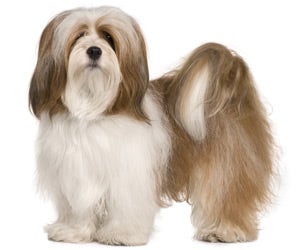Lhasa Apso
-
Overview
View Grooming Diagram for lhasa apsoThese assertive little dogs have a unique personality that allows them to be serious guard dogs in one instant and cuddly companions in the next. They are trustworthy and devoted guard dogs who can be wary of strangers but devoted to their owners, who love them for their playful instincts and gorgeous coats.
-
Personality
-
Coat Care

The Lhasa Apso loves to look his best. That gorgeous coat will take some effort to groom. Daily brushing and combing is necessary for dogs without short clips. Brush out their flowing coats with a wire brush and a rake-like comb to avoid mats and tangles.
Your Lhasa Apso will need to be bathed to keep his long coat from becoming dirty, but because these dogs to not naturally enjoy the water, help him get used to bathing as a puppy.
Lhasa Apsos do not shed frequently, so trimming occasionally around their paws and eyes will help them avoid discomfort. If you choose to keep your dog in a puppy clip, he will need to be clipped frequently and trimmed carefully around his face.
Many dog owners are apprehensive about trimming their dog’s nails because they are nervous about cutting into the quick. But with the right conditioning and careful cutting, nail clipping can be a simple, stress-free activity for you and your dog.
Provide your dog with plenty of positive reinforcement and even treats to help associate nail clipping with a positive experience. As you start to clip, gently press on your dog’s paws to help him become accustomed to the feeling of having his nails clipped. Then, work gradually, shaving down just a thin portion of the nail at first to make sure you don’t reach the quick. Clip one nail, reward your dog with a treat, and stop to give him some positive reinforcement before moving on. Gradually increase the number of nails you clip in one sitting to help your dog get used to the process. Never trim extremely long nails down to a short nail in one sitting, because this is an excellent way to accidently quick the dog’s nail. Instead, work gradually, shaving small portions of your dog’s nails off each time.
You can tell if you’re getting close to the quick by the texture of your dog’s nail. The nail is hard closer to the surface and becomes softer as you get closer to the quick. If your dog’s nail starts to feel softer, that’s a good indication that you’re getting close to the quick.
Not all breeds and coat styles require routine trimming in and around the eyes and ears but all should undergo regular inspection and cleaning around these sensitive areas. Doing so will help prevent the development of infections that could seriously damage these amazing organs.
It is always important to routinely clean your dog's eyes and ears, and examine for potential infections. Drop coated dogs have sensitive ears and long hair that tends to grow into the ear. Their ears need to be checked weekly for infection and cleaned with a cotton ball. Gently wipe a cotton ball moistened with mineral oil, olive oil or witch hazel in your dog's ear, being careful to avoid the ear canal. Never use a Q-Tip, which could cause damage to the inner ear if your dog suddenly shakes or jerks his head. Bushy hair growth within the ear can be thinned with tweezers or blunt scissors. Use a small trimmer to trim excess hair around the eyes, ears and face. Small dogs like Shih Tzus and Havanese are prone to developing tear stains around their eyes, so clean around their eyes with a cotton ball or soft cloth and use a small trimmer to trim excess hair around their eyes.
Lhasa Apsos are also prone to dental problems, so help your dog become accustomed to tooth-brushing routines early in their puppy years. Brush their teeth daily if possible.

 India (English)
India (English)
 Middle East and Africa (English)
Middle East and Africa (English)
 South Africa (English)
South Africa (English)
 Australia (English)
Australia (English)
 Japan (日本語)
Japan (日本語)
 South East Asia (English)
South East Asia (English)
 Singapore (English)
Singapore (English)
 Europe (English)
Europe (English)
 United Kingdom (English)
United Kingdom (English)
 Argentina (Español)
Argentina (Español)
 Brazil (Portuguese)
Brazil (Portuguese)
 Colombia (Español)
Colombia (Español)
 Latin America (Español)
Latin America (Español)
 México (Español)
México (Español)
 Chile (Español)
Chile (Español)
 Peru (Español)
Peru (Español)
 Canada (English)
Canada (English)

